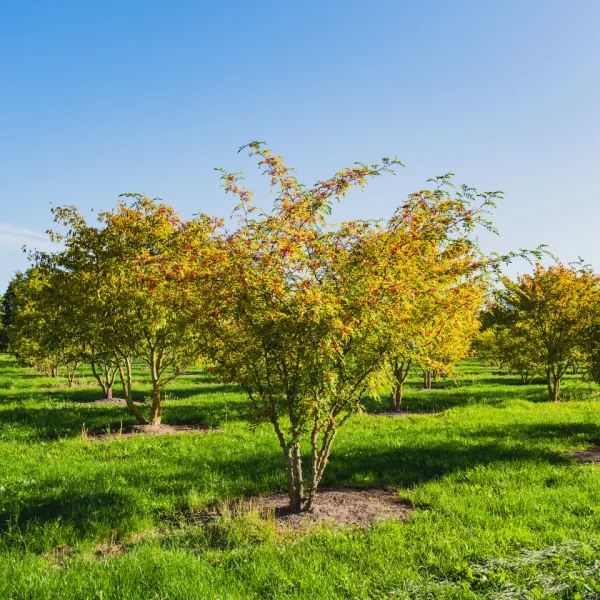Kalopanax septemlobus – prickly castor oil tree
Araliaceae
Kalopanax septemlobus – prickly castor oil tree
Kalopanax septemlobus este un arbore foarte distinctiv, oarecum asemănător cu Aralia, cu care este înrudit. Cu toate acestea, arborele se deosebește în mod clar de acesta în mai multe privințe. K. septemlobus crește distinct în poziție verticală și atinge 10-15 m înălțime. În cazuri excepționale, copacul poate depăși 20 m înălțime. Crengile groase sunt acoperite cu spini ascuțiți. Pe scoarța mai bătrână, acestea dispar, după care scoarța devine canelată. Frunzele mari se află în principal la vârful crengilor. Acestea sunt lobate palmat, cu lobi care variază în adâncime. Frunzele se deschid de un verde destul de deschis și vara sunt de un verde închis lucios. Toamna, se colorează în galben închis spre galben-maroniu înainte de a cădea. La sfârșitul verii, apar paniculele largi, în formă de umbeliță, cu flori albe mici. Florile individuale sunt dispuse în mănunchiuri globulare, care împreună formează paniculele. Paniculele au o lungime și o lățime de aproximativ 30 cm și sunt înghesuite de albine.
După înflorire, apar boabele mici, de culoare albastru-negru, care sunt, de asemenea, ornamentale. K. septemlobus crește cel mai bine în sol bogat în nutrienți, umed, în plin soare. Prin natura sa, este un arbore care crește la poalele pantelor montane și de-a lungul malurilor râurilor. Nu tolerează pavajul și, prin urmare, este un arbore de parc prin excelență.
După înflorire, apar boabele mici, de culoare albastru-negru, care sunt, de asemenea, ornamentale. K. septemlobus crește cel mai bine în sol bogat în nutrienți, umed, în plin soare. Prin natura sa, este un arbore care crește la poalele pantelor montane și de-a lungul malurilor râurilor. Nu tolerează pavajul și, prin urmare, este un arbore de parc prin excelență.
This product is currently not available.
You can submit your request via the contact form, we will inform you without obligation about the possibilities.
Specifications
Download PDF
Height
10-15(25) m
Width
10-15m
Crown
round/spherical, light, open crown, capricious growing
Bark and branches
trunks set with many spines
Leaf
green
Flowers
white, flowers in July
Fruits
blue, black
Spines/thorns
Yes
Toxicity
usually not toxic to people, (large) pets and livestock
Soil type
clayed soil, loamy soil, sandy soil, peaty soil
Paving
tolerates no paving
Winter hardiness zone
5b (-26,0 to -23,4 °C)
Wind resistance
good
Other resistances
resistant to frost (WH 1 - 6)
Application
industrial areas
Shape
multi-stem treem
Possibly of interest
Frequently asked questions
Kalopanax septemlobus
Kalopanax septemlobus can eventually reach a height of 10-15(25) m, depending on the site and climate conditions.
Kalopanax septemlobus has a average growing and can eventually reach a height of 10-15(25) m, depending on the site and climate conditions.
The right time to plant Kalopanax septemlobus is during the dormancy period. In Western Europe, Kalopanax septemlobus with root balls can generally be planted from mid-November to late April, although this depends strongly on the climatic conditions and the species of tree.
july.
General
 English
English
 English (United Kingdom)
English (United Kingdom)
 Nederlands
Nederlands
 Nederlands (België)
Nederlands (België)
 Deutsch
Deutsch
 français
français
 čeština
čeština
 polski
polski
 español
español
 română
română
 dansk
dansk
 svenska
svenska
 magyar
magyar
 Türkçe
Türkçe
 slovenčina
slovenčina
 русский
русский
 norsk
norsk







